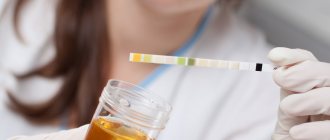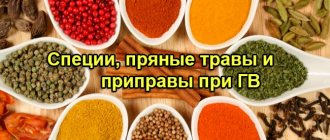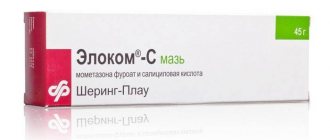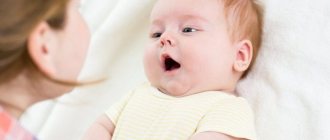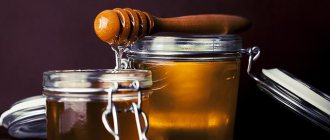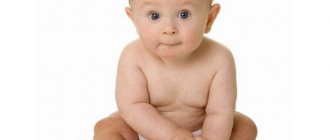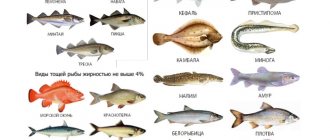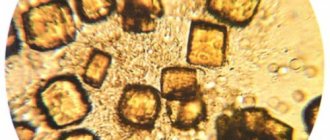What is acetone in urine
If the blood test is normal, then the presence of acetone in it is excluded. Acetone bodies are an intermediate product of energy metabolism during the “combustion” and biochemical transformations of fats, proteins and carbohydrates. Slow carbohydrates, which are part of the daily diet, are broken down and form glucose - the main supplier of energy, without which existence is impossible. When the level of dextrose in the blood drops, the body begins to break down its proteins and fats to replenish it.
This deviation is called gluconeogenesis. As a result of the breakdown of fats and proteins, toxic acetone bodies appear, which are first oxidized in the tissues to non-hazardous products, and then excreted by the kidneys and exhaled air.
When ketones are formed faster than they can be utilized, they begin to destroy the brain and then other cells. They damage the gastrointestinal mucosa, causing vomiting. The child's body becomes dehydrated. Metabolic disorders intensify, the blood becomes “acidic” - metabolic acidosis develops.
Attention: Without proper and timely treatment, a child can fall into a coma and die from dehydration or due to impaired cardiac function.
Reasons for increased acetone in children
Several factors can cause ketoacidosis in children.
- Poor nutrition. The child's body does not digest fatty foods well; even a single intake of excessively fatty foods can lead to the accumulation of acetone in the child's blood and urine.
- Malnutrition. As a result of a lack of nutrients, the body uses its own reserves and expends more energy than usual. As a result, there is little energy left for the disposal and removal of biological poisons. Toxins accumulate in the body, leading to vomiting.
- Serious illnesses. Diabetes mellitus, infections in the intestines, concussions, anemia, oncology - can lead to the accumulation of acetone in children. But still, a common reason that provokes this disease is neuro-arthritic diathesis (disturbance of normal metabolism).
Acetonemia can be either regular or sudden. This phenomenon occurs in children of different ages, from the first year of life to 13 years. In a child at this age, the internal organs and systems are already fully formed, they function fully, and therefore acetone bodies will no longer accumulate in critical volumes.
Symptoms by which the disease can be recognized
With acetonuria resulting from ketoacidosis, children exhibit the following symptoms:
- vomiting after eating or drinking, including after plain water;
- intestinal colic;
- moderate headache;
- increased body temperature;
- water depletion of the body (rare urge to empty the bladder, diarrhea, dry skin, unnatural blush, coating on the tongue);
- the smell of rotten apples from the mouth, from urine and vomit.
Parents may notice pale skin or slight jaundice, lack of interest in play, and an apathetic facial expression. In patients with prolonged ketoacidosis:
- there is an increase in liver size;
- heart sounds weaken;
- heart rhythms are disturbed;
- heart rate increases
The main method for diagnosing acetone used in children is urine testing. You can confirm the diagnosis at home using test strips. When immersed in urine, the color changes to pink, and with an increased concentration of acetone bodies, the strip takes on a purple hue.
Important: In especially severe cases, acetone destroys brain cells, causing lethargy and loss of consciousness. It is prohibited to stay at home in this condition. The patient requires hospitalization, otherwise he may fall into a coma.
Symptoms
Acetonemic syndrome is accompanied by a noticeable deterioration in well-being in the form of the following symptoms:
If a child exhibits such symptoms, you should immediately contact a medical facility. A qualified doctor will examine you and prescribe the necessary laboratory tests to confirm the initial diagnosis. Based on the results of laboratory tests, appropriate treatment is selected for the child and a dietary menu is prescribed.
If the child's condition rapidly deteriorates and vomiting does not stop, intravenous fluids are used.
This measure helps to cope with ketone body intoxication and prevent dehydration.
With timely consultation with a doctor and proper treatment, the child’s condition improves on the second to fourth days. In parallel with drug treatment, a special diet is prescribed for increased acetone in the urine in children.
Expert opinion
Guseva Yulia Alexandrova
Specialized endocrinologist
Test strips are used to determine the amount of ketone bodies in urine.
Drink for a child with elevated acetone
In addition to diet, the main key to successful treatment is the correct drinking regimen. Do not limit your baby to water alone; give him drinks enriched with fructose (and therefore glucose). For these purposes, dried fruit compote will do. The drink should be warm. To improve the taste, you can sweeten the broth with honey.
High concentration of fructose in raisins. If the child likes it, then let him eat dried grapes, but it is better to make an infusion from it. To do this, take a handful of raisins, pour 200 ml of boiled water over it, cover and let it brew for 15 minutes. After the infusion has cooled, strain and give to the child.
The child will not refuse warm tea. In this case, sugar should be replaced with fructose. It breaks down faster in the body and also eliminates a sharp jump in blood glucose.
Alkaline drinking will help disperse acetone bodies already accumulated in the body. Alkaline mineral waters (Essentuki No. 4, No. 17 or Borjomi) and electrolyte solutions (Regidron) cope well with this task.
Important! To prevent the appearance of acetone, give your baby sweet drinks after exercise, stress, and during illness.
Basic rules to follow when drinking:
- drinks should be warm, so they are easier to digest;
- Give your child food often and in small portions (1-2 tablespoons every 15 minutes);
- the drink should be sweetened, but it must be taken into account that the daily amount of glucose is limited to 5 mg per 1 kg of weight (liquid - 120 ml / kg).
What should parents do?
It is important to hold out for 5-6 days, after which the children’s body begins to actively produce enzymes that neutralize ketone bodies, and they are actively excreted by the kidneys. After this, the baby’s condition gradually normalizes. The most important thing during this time is to prevent disruption of the water-salt balance, in other words, dehydration and provide the body with a sufficient amount of glucose.
- First of all, it is necessary to feed the child, constantly replenishing fluid reserves. For high levels of acetone, a pharmaceutical glucose solution is best suited. A drink that is at body temperature is absorbed most quickly. Drink in small sips, so as not to provoke vomiting, every 15-20 minutes.
- You need to offer your baby any sweet drinks that he agrees to, alternating them with liquid glucose and oral rehydration solution (you can buy pharmacy powder or prepare it yourself)
- Do not feed the child, especially if he does not ask. If you really want to eat, offer a couple of spoons of baked apple, but not earlier than 3 hours after the last attack of vomiting.
- If you can’t get your child to drink: he refuses to drink, or every sip ends in vomiting, hospitalization may be necessary - the baby will need an IV.
photo Legion-Media
Diet with acetone during an exacerbation
The first days of development of the pathological condition are extremely difficult for the baby to bear. Symptoms such as repeated vomiting, diarrhea, and deterioration in health aggravate the course of the disease. The body directs all its forces to eliminate toxins. It is quite logical that the baby refuses to eat. Parents should know what their child can eat with elevated acetone levels in order to help their child during this difficult period.
- To begin with, it is enough to provide the baby with plenty of fluids in accordance with the above recommendations.
- After vomiting has stopped and the temperature has returned to normal, the patient can be offered a few crackers prepared at home from white bread.
- On the second day, the children's menu can be diluted with baked apples and rice-based broth. To prepare it you need to take 100 grams. white cereal, add three liters of water and cook without adding salt or other spices.
- The next day, you can add boiled rice porridge to your baby’s diet. If desired, you can grind it using a blender.
- On the fourth day (from the day the crisis ends), the child can be offered vegetable soup. It should be light, i.e. heavy foods such as fats, mushrooms and legumes should be completely excluded. Otherwise, the children's gastrointestinal tract will not cope with food.
- The transition to the usual menu should be slow and gradual. Starting from the fifth day, the menu can be expanded within the limits of the permitted diet for ketoacidosis.
Diet for acetone syndrome in children
Avoid prohibited foods until your baby is fully recovered. His meals should be fractional, 5-6 times a day. Don't take long breaks between meals. It's good if steamed vegetables are included in every meal.
Only an experienced doctor can prepare an approximate diet for a child. The diet is approved and adjusted by a specialist. Introduce new products gradually, monitor the body's response.
Try to make your baby's menu as varied as possible. Give him the opportunity to love his diet. After all, the baby will have to eat this way for about 2-3 months.
Products prohibited with elevated acetone
A proper diet will prevent an increase in the concentration of acetone in the urine. Nutrition with acetone in children involves the complete exclusion of ketogenic products. These include:
- fatty meat, fish;
- smoked meats;
- rich broths;
- marinades;
- mayonnaise, sour cream;
- fatty dairy and fermented milk products;
- sauces and spices;
- offal;
- mushrooms;
- coffee, cocoa and products containing them;
- fresh bakery;
- lemons, oranges, grapefruits;
- sorrel;
- tomatoes.
You should remove fast foods, soda, store-bought juices, chips and other foods high in preservatives from your diet.
Features of the Komarovsky diet
To relieve exacerbations of the disease, Dr. Komarovsky recommends not letting the child starve. A diet with acetone for the first few days should consist of eating porridges and purees cooked in water. You can also give children biscuits and baked apples to eat.
After vomiting stops, the menu can be expanded with milk, vegetable soups, meat and kefir.
Komarovsky also recommends feeding the child low-fat, non-fried foods for 21 days after completing the diet. All dishes must be steamed or boiled.
What should be in a child's diet
The following products are allowed to be included in the diet menu:
- milk and dairy products, the fat content of which does not exceed 5%, and do not contain sugar (ryazhenka, kefir, cottage cheese and yogurt);
- buckwheat, oatmeal, rice, corn and wheat liquid porridge with a boiled consistency (in the first days after the crisis);
- vegetables - may be eaten raw, boiled, stewed or baked;
- sweet fruits and berries;
- boiled eggs, recommended daily dose - 1 pc.;
- lean meat (rabbit, turkey, veal, chicken);
- lean sea fish (pollock, hake, flounder, etc.);
- crackers, nuts, dried fruits;
- honey, marshmallows, jam, marmalade - in moderation.
Important! Milk is initially limited and given as an additive to water-based cereals.
A diet for children with acetone requires adherence to certain rules.
- Fractional meals. Feed every three hours in small portions.
- During the diet, foods should be boiled, baked or stewed. Don't fry!
- It is better to give fish and meat to your baby in the form of souffles, meatballs and meatballs.
- Have dinner no later than 19:00. Food should be light. At night you can drink 200 ml of fermented milk product with 0% fat content.
- Be sure to give your child vegetables rich in fiber.
- All dishes must be freshly prepared.
After recovery, you must adhere to a special diet for another two weeks, gradually returning to your previous food.
An example of one day of diet in children after acetone is as follows:
- breakfast - buckwheat porridge on water with milk in a ratio of 1 to 1, you can eat a banana;
- lunch - fruits or berries;
- lunch - vegetable soup with small pasta, steamed turkey cutlets and a salad of fresh vegetables, seasoned with low-fat sour cream;
- afternoon snack - a piece of biscuit and tea;
- dinner - fish soufflé, vegetable puree, fruit mousse;
- before going to bed - natural yogurt with crackers.
The fish soufflé recipe includes the following ingredients:
- sea fish fillet - 500 gr.;
- egg - 1 pc.;
- milk - ½ cup;
- flour - 1 tbsp. l. without slide.;
- water - ¼ cup;
- butter - 1 tsp;
- salt to taste.
Place fish fillet, cut into pieces, in a frying pan, add water, then add grated carrots. Simmer until the water evaporates (about 15 minutes). Grind the products with a blender. Add the yolk and stir thoroughly. Pour milk into a clean frying pan, add flour and stir so that there are no lumps. Put on fire and cook until thickened. Add oil at the end. Add the sauce to the main dish, add salt and stir. Add the beaten egg white, place the finished mixture in a 3-4 cm layer in the pan. Cook in a water bath. Then place in an oven preheated to 200C and cook until the top crust is browned (25-30 minutes).
food with acetone. Pioneer's memo
t_e_r_e_z_a
Dietary recommendations for children with acetone syndrome
Unreasonable fatigue portends illness. Hippocrates
The other day my baby had digestive problems. After taking a urine test, it showed the presence of acetone, and the smell of acetone from the child’s mouth also indicated it. Fortunately, the crisis has already passed.
The pediatrician gave a leaflet with “Recommendations for nutrition of children with acetone syndrome” from the Department of Pediatrics No. 2 of NMAPE (head of the department - Professor V.V. Berezhnoy, Associate Professor L.V. Kurilo).
I am reprinting its contents, so I will always have it at hand and, if anything happens, I hope it will help other mothers. Nutrition principles: * The main principle is a constant hypoketogenic diet, i.e.
exclusion of foods containing purine bases, limitation of foods containing fats. * Frequent split meals (5 times a day). *Do not force feed. * The child chooses his own food.
Diet for acetone crisis:
* At the stage of precursors (lethargy, adynamia, nausea, refusal to eat, the smell of acetone from the mouth, migraine-like headache, cramping in the abdomen) and during the period of crisis (except for the period of illness when there is vomiting), the child should not starve. * An aketogenic diet is prescribed - oatmeal, buckwheat, corn porridge cooked in water, mashed potatoes in water, biscuits, baked sweet apples. * With stopped vomiting and improvement of general condition and restoration of appetite, the diet is expanded to include milk, kefir, vegetable soup, and meat. * For 2-3 weeks, food according to table No. 5 (gentle, non-irritating, without seasonings, smoked meats, marinades, foods cooked mainly steamed or boiled) within the framework of the diet described above. * Frequent fractional meals at all stages of the crisis using rehydron (or oralit, humana-electrolyte, gastrolite), non-carbonated alkaline mineral water (Polyana Kvasova, Luzhanskaya, Borjomi), dried fruit compotes. * After stopping the crisis, taking drugs that help normalize the level of acid in the blood (CanephronN) and drugs that improve metabolic processes in the body (cocarboxylase, ATP, cardonate).
Meat products and dishes made from them
* POSSIBLE: meat of adult animals (beef, lean pork), rabbit meat, turkey, boiled eggs (one per day) or scrambled eggs.
* LIMIT: corned beef, canned food. * NOT allowed: soups and borscht with meat and bone broth, veal, young poultry, offal (liver, kidneys, brains), smoked meats, marinades.
Fish and seafood
* POSSIBLE:: sea fish, green or brown algae.
* LIMIT: herring (soaked), salted fish, fish caviar, non-fish seafood (krill, crab sticks, crabs). * NOT allowed: soups with fish broth, river fish (with the exception of pike perch and pike), crayfish.
Vegetables and dishes made from them
* POSSIBLE:: soups with vegetable broth, potatoes, beets, carrots, cucumbers, zucchini, white cabbage, onions, radishes, lettuce, dill.
* LIMIT: borscht using tomatoes, orange tomatoes, raw cauliflower, radish, dishes made from legumes and peas. * NOT: soups with mushroom broth, green borscht, red and pink tomatoes, eggplants, sweet peppers, boiled cauliflower, white mushrooms and champignons, spinach, sorrel, parsley, rhubarb, ketchup, adjika, mayonnaise.
Cereals, flour products and sweets
* POSSIBLE:: buckwheat porridge, rolled oatmeal, rice, corn, crackers, shortbread cookies, marmalade, jelly, Turkish delight, caramel.
* LIMIT: pasta, sponge cake, cupcake. * NOT: baked goods, puff pastry, chips, confectionery with cream, chocolate.
Fruits and berries
* POSSIBLE:: sour apples, pears, sweet berries, grapes, cherries, peaches, watermelon, melon, apricots.
* LIMIT: bananas, kiwi, dates, figs, tangerines. * DON'T: sour fruits (apples, cherries, oranges).
Dairy products and dishes made from them
* POSSIBLE: milk, kefir, fermented baked milk, cottage cheese, processed cheese, feta cheese.
* LIMIT: sour cream, cream, hard low-fat cheese. * NOT: fatty cottage cheese, cheese.
Drinks and juices
* POSSIBLE:: Dried fruits (apricots, plums, dried apricots, raisins) in the form of compote, blackcurrant juice, cranberries, jelly, juices with pulp, freshly squeezed, green tea, lemon drink.
* NOT: rosehip decoction, black tea, coffee, cold and carbonated drinks, concentrated juices.
Be sure to consult a doctor! Do not self-medicate your child!!!
Prevention
To help the young body cope with the harmful effects. It is necessary to take care of the proper organization of your lifestyle. A number of recommendations will help with this.
- Maintaining a healthy lifestyle. In this case, daily walks, outdoor games and moderate physical activity are useful. No less important are hygienic and health procedures - taking baths, rubbing with cool water and others.
- Good food. Children's diets must include cereals, milk products, vegetables and fruits.
- Sleep quality. A well-slept and rested body works at full strength, which reduces the risk of acetone accumulation.
- Prevention of the development of infections. Timely vaccination and strengthening the immune system with vitamins and minerals. Annual blood and urine tests, ultrasound examination of internal organs.
All of the above preventive measures are prescribed not only for children with acetone syndrome, but also for healthy children, because taking care of the immune system always comes first.
Preparing meals for the diet
To make it easier for mothers to diversify the diet for their children, below are some of the most popular recipes.
Rice soup with vegetables
Peel two potatoes and finely chop with a knife. Chop a quarter of the onion and one carrot into small pieces. Add prepared vegetables to half a liter of boiled water. Add a little salt.
After simmering for fifteen minutes, add two tablespoons of rice to the pan. Let the soup cook for another fifteen minutes. After turning off the finished dish, let it stand under the lid for another five minutes.
Stewed potatoes
Cut two potatoes into cubes. Add the prepared vegetable to the boiling water. Also throw finely chopped carrots and a quarter of an onion into the pan. Add a little salt. Cover the pan with a lid and let simmer over low heat for forty minutes.
